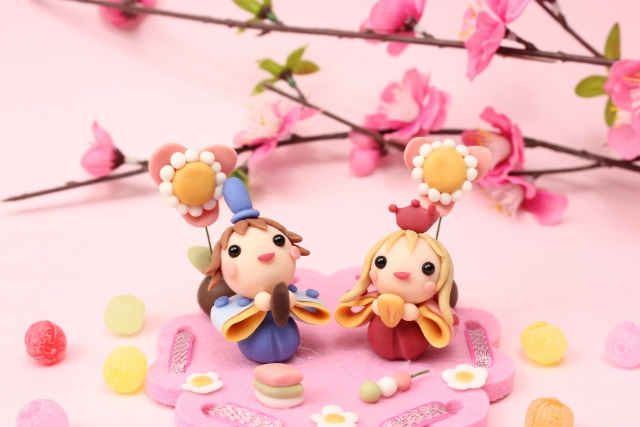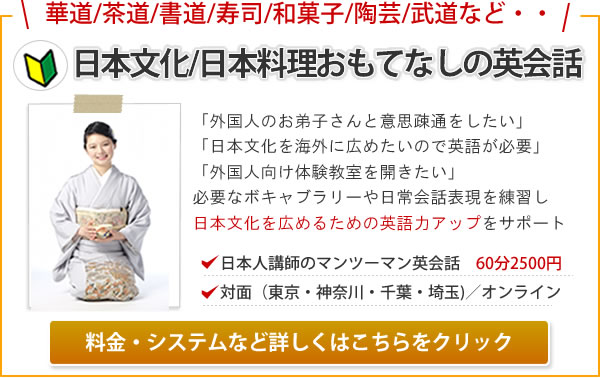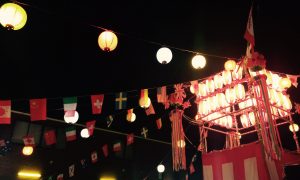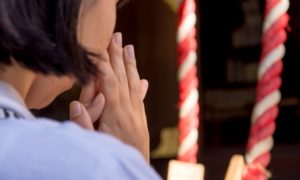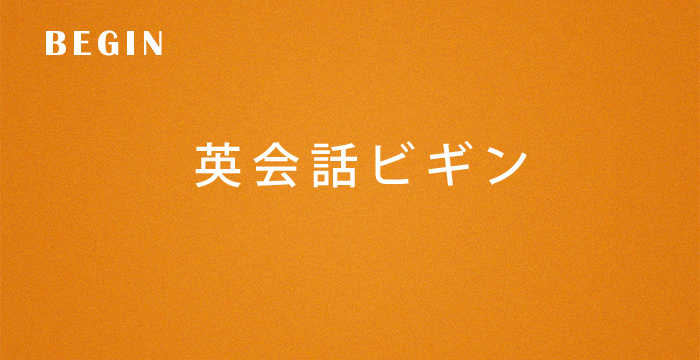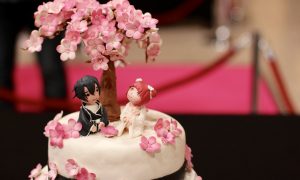3月3日はひなまつりですね。
子供のための日本の伝統的な行事、それは3月3日の女の子のためのひな祭りと5月5日の男の子のための端午の節句です。
現在では5月5日は「子供の日」と称されていますが、元来は男の子のための節句でした。
それぞれの日にどのようなものが飾られ、そしてそれらにはどのような意味があるのかということを英語で説明していきたいと思います。
3月3日は女の子たちのお楽しみ
3月3日は何の日?
3月3日は「ひな祭り」と呼ばれる日本の伝統的な女の子のお祭りの日で、女の子たちが一年のうちで心待ちにする日の一つです。
March 3rd is the Japanese traditional Girl’s festival. It is one of the days when girls look forward to the occasion in the year.
3月3日に何を飾るの?
この日が「ひな祭り」の日と呼ばれるように、女の子がいる家庭ではひな人形が飾られます。
ひな人形は優美な着物を着た天皇と皇后を表す人形とあとは宮廷で働く人たちを表し、他に鏡や箪笥、針箱などのお道具などが七段の飾り棚に飾られます。
近頃ではひな人形の棚を置くだけのスペースがない場合は、天皇、皇后を表す人形のみをガラスケースの中に飾るときもあります。
As this day is called the Doll festival, the family with one or more girls display hina dolls.
Hina dolls represent the Emperor and the Empress dressed in a graceful kimono and the people who work in the Court.
Also, a mirror, drawers, a sewing box are displayed on the shelf with seven steps.
Nowadays, there is not enough space to place the shelf for hina dolls, they sometimes display only the dolls of the Emperor and the Empress in a glass case.
なぜひな人形を飾るの?
なぜそのような天皇・皇后や宮廷で働く人たちの人形を飾るのでしょうか?
女の子の親たちは子供たちの健康な成長を祝い、そしてひな人形のように優美になるようにと願い、ひな人形を飾るのです。
Why do they display such dolls of the Emperor and the Empress and other people working in the Court ?
The parents of girls display hina dolls to cerebrate their healthy growth, and also hope that they continue to grow as gracefully as the hina dolls.
男の子のお祭りは5月5日
今は子供の日だけれど
5月5日は今は「こどもの日」と呼ばれ、男の子であれ女の子であれ健康で幸せになりますようにと親が願う日です。
しかし、第二次世界大戦終了まではこの日は「端午の節句」と言われ、男の子のお祭りの日でした。
Now, May 5th is called “Children’s Day “and this is the day when the parents hope both boys and girls become healthy and happy.
However, this day was the Boy’s festival called “Tango-no-sekku ” just before the Second World War was over.
「子供の日」とは言うけれど
この日を「子供の日」とは言うものの主に男の子のためのお祭りです。
男の子がいる家庭では武士の人形や甲を飾ります。
これは男の子たちの両親が彼らにできるだけ強くなってほしいと願っていることを意味します。
また、庭には鯉のぼりを飾る人もいます。
Although we call this day ” Children’s Day “, it is mainly a Boy’s festival.
In the home with one or more boys they display warrior dolls and a helmet.
It means that the parents of the boys hope they would become as strong as possible.
Some people display koinobori or a streamer in the shape of a carp in the yard.
なぜ鯉なの?
中国の伝説で鯉は急流を登って竜になると言われています。
その伝説が日本に伝えられました。
男の子の親たちは彼らに鯉のように強くなってほしいと願うのです。
It is said in the Chinese legend that a carp becomes a dragon after it succeeds in climbing the torrent and this legend was introduced to Japan.
The parents of boys want them to become as strong as a carp.
■練習問題
次の文章は「ひな祭り」と「子供の日」についてまとめたものです。
( )内の日本語を参考にして文章を完成させてください。
Hinamatsuri is a ( 女の子のお祭り) held on March 3rd.
The parents of girls display hina dolls and hope they would grow as (優美に) as hina dolls that represent the people in the (宮殿).
May 5th is called (子供の日) now but until the end of the Second World War was over, it was called Tango-no-sekku or a Boy’s festival.
Today the parents of boys display (武士の人形), (甲), and (鯉のぼり)and they hope that they would grow as ( 強く)as those things.
解答
女の子のお祭り→ Girl’s festival
優美に→ gracefully
宮殿→ Court
子供の日→ Children’s Day
武士の人形→ warrior dolls
甲→ a helmet
鯉のぼり→ a streamer in the shape of a carp
強く→ strong
まとめ
女の子が宮殿の人たちのように優美に成長しますようにと3月3日にひな人形を飾ってお祝いをし、そして5月5日に男の子も女の子も元気に成長しますように、そして男の子は強くたくましく成長しますようにと願って武士の人形や甲や鯉のぼりを飾ってお祝いをするこれらの風習は日本独特のものです。
親の願いを飾り物に託すこの習慣を外国人に分かってもらえれば、素敵な日本の伝統文化がまた一つ発信できることと思います。
